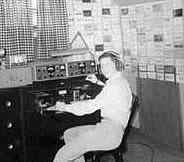Ken Widelitz, K6LA / VY2TT
(formerly WN2TFK, 1965)
In 8th grade, in 1965, at age 15, I was having lunch in the school cafeteria in Cresskill NJ, a suburb of NYC, with my buddies. One said, “I’m going to get my ham license.” Another said, “I’m going to do that too.” Now, I’d had a shortwave receiver, a National NC-77X, for a few years, but never listened to the ham bands. I liked SWLing and hearing broadcasts from foreign countries, so I said, “OK, I’ll get mine too.” I practiced CW listening to a 33 RPM vinyl record and finally learned the code. I took my test in the basement of the elementary school in the bomb shelter which doubled as the Civil Defense headquarters. I still have that piece of paper.
 While waiting for my ticket, my buddies and I each built a 40 watt 6146B based, crystal controlled 40 and 80 meter CW transmitter from a circuit in Popular Electronics. We went to NYC’s electronics district, Cortland Street (which was torn down to make way for the World Trade Center) to buy our parts. Our trip consisted of the bus to the George Washington Bridge, which we usually walked across to save money. Then a long subway ride on the A train, off at Canal St. Small dusty store after store, each with racks and racks of small cardboard boxes filled with parts. One store had the best price on resistors, another specialized in transformers, another in tubes, etc. We came to know them all. When the transmitter was finished, the big question was, would it work? Of course, we didn’t have our licenses in hand yet. What to do? Dave Poppins, the infamous FCC monster, namesake of the “Poppinsgram,” lived in the next town over. If we tested out the rig, would he catch us? I took the chance. I keyed up the transmitter. Nothing. The most technical of my friends came over and found I had soldered the output to ground at the SO-239. That was fixed and he could here me across town. Dave Poppins didn’t bust me. While waiting for my ticket, my buddies and I each built a 40 watt 6146B based, crystal controlled 40 and 80 meter CW transmitter from a circuit in Popular Electronics. We went to NYC’s electronics district, Cortland Street (which was torn down to make way for the World Trade Center) to buy our parts. Our trip consisted of the bus to the George Washington Bridge, which we usually walked across to save money. Then a long subway ride on the A train, off at Canal St. Small dusty store after store, each with racks and racks of small cardboard boxes filled with parts. One store had the best price on resistors, another specialized in transformers, another in tubes, etc. We came to know them all. When the transmitter was finished, the big question was, would it work? Of course, we didn’t have our licenses in hand yet. What to do? Dave Poppins, the infamous FCC monster, namesake of the “Poppinsgram,” lived in the next town over. If we tested out the rig, would he catch us? I took the chance. I keyed up the transmitter. Nothing. The most technical of my friends came over and found I had soldered the output to ground at the SO-239. That was fixed and he could here me across town. Dave Poppins didn’t bust me.
A few weeks later, just before my French final, the envelope came and I was WN2TFK. I didn’t do very well on that French final. The furthest I got with that transmitter was Ohio. Not too long after, my family moved to a bigger house at the top of the hill on the same street in the same town. I got a big attic room with an alcove perfect for my shack (see photo.) One fall Saturday afternoon, I went back to Cortland St. and bought an EICO 720. When I got home, my ham buddies sat in my shack while I CQ’d forever with no response. Needless to say, I was down in the dumps. Then, at about 3 AM the next morning, after a long CQ, I tuned that ½ on the fine tuning control on the NC-77X that was the 80m novice band, and heard WB6LQD come back to me. Joy! The QSO lasted about 20 minutes. As soon as I said 73, I ran to my parent’s room and started jumping up and down on their bed yelling, “I got California, I got California.”
The other most memorable moments from my novice days were getting hooked on contesting at field day. Later that year, I made 50 QSOs in the CW Sweepstakes. Sure seemed like a lot at the time. Now if I make 50 QSOs in an hour, it seems VERY slow.
73, Ken, K6LA / VY2TT |